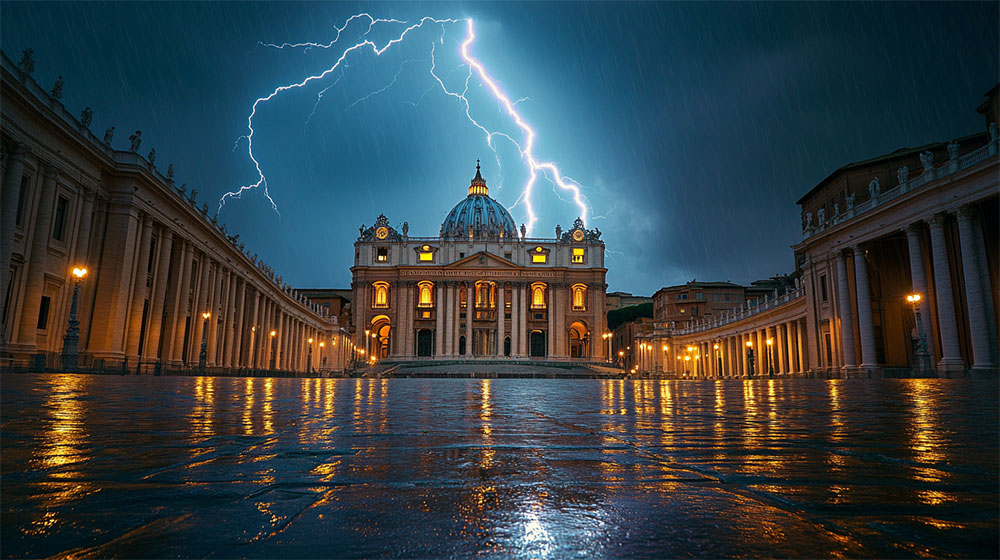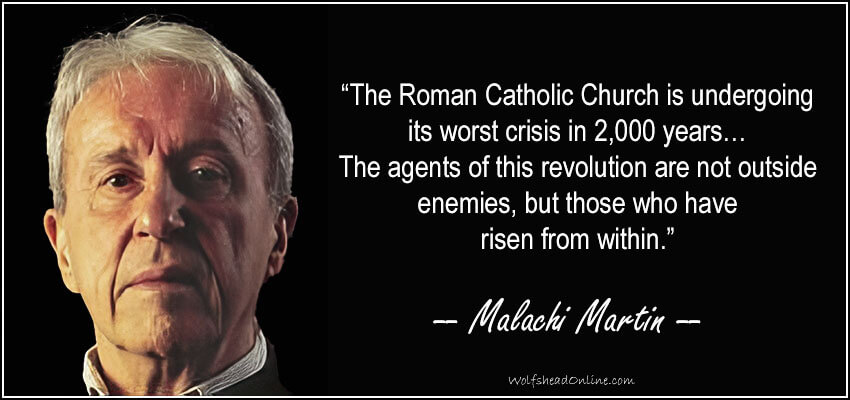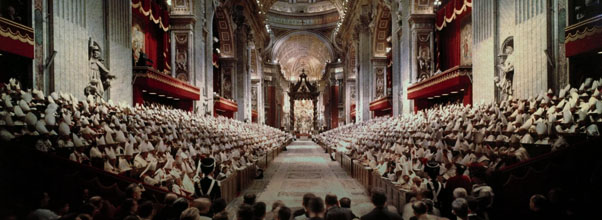The Second Vatican Council (1962–1965) and the subsequent implementation of the Novus Ordo Missae were sold to the faithful as a renewal. We were told it would foster unity, increase participation, modernize the Church, and spark a new springtime. Yet over sixty years later, the results are in—and they are devastating.
Rather than revitalization, what we have witnessed is decline: in reverence, vocations, catechesis, moral clarity, and belief in core doctrines. Churches have emptied, altars have been stripped, and the sacred has been replaced with the banal. A generation has grown up with little sense of the transcendent, and many Catholics can no longer articulate the very basics of their faith.
The new liturgy, presented as a gift to the people, has too often become a man-centered performance. Sacred mystery has been traded for casual familiarity. Once-unthinkable liturgical abuses—clown Masses, puppet homilies, and felt banners—have become symbolic of a deeper crisis: the abandonment of tradition.

Christ told us that a tree is known by its fruit. The post-conciliar Church must be judged by this standard—not by idealistic hopes or the good intentions of its architects, but by the real-world outcomes experienced by millions of faithful Catholics around the world.
The Bad Fruits of Vatican II and the Novus Ordo Mass
1. Collapse in Mass Attendance
Mass attendance among U.S. Catholics dropped from 75% in the 1950s to around 22% by 2019 (CARA, Georgetown University). Critics attribute this to the loss of transcendence in the Novus Ordo Mass, which often resembles a community gathering more than a sacrifice offered to God. With weakened catechesis and a man-centered liturgy, the sense of obligation and awe surrounding Sunday Mass has nearly vanished for many.
2. Loss of Liturgical Reverence
The replacement of Latin with the vernacular, the priest facing the people (versus populum), and the removal of sacred elements such as Gregorian chant, incense, and the altar rail have all contributed to a desacralized atmosphere. The removal of the St. Michael Prayer after Mass, once a spiritual bulwark against evil, and the abandonment of kneeling to receive the Eucharist have further eroded reverence. The sanctuary has been flattened—both symbolically and literally.
3. Vocations Crisis
Priestly and religious vocations have collapsed. In 1965, there were 59,000 priests in the U.S.; by 2023, that number dropped to 34,000 (USCCB), despite population growth. Critics argue that Vatican II-era theology downplayed the priest’s unique role as alter Christus, and the feminization of the sanctuary—particularly the introduction of female altar servers—has discouraged boys from serving, cutting off a vital pipeline to priestly vocations.
4. Doctrinal Confusion and Religious Indifferentism
Documents such as Nostra Aetate and Unitatis Redintegratio are criticized for introducing ambiguity about the Church’s claim to possess the fullness of truth. Many Catholics now believe all religions are equally valid paths to salvation. This has led to widespread confusion about the necessity of the Church, the authority of doctrine, and the urgency of evangelization.
5. Collapse in Belief in the Real Presence
A 2019 Pew Research study found that only 31% of U.S. Catholics believe in the Real Presence of Christ in the Eucharist. This collapse in belief is tied to the desacralized presentation of the liturgy—receiving Communion in the hand while standing, the abuse of lay Extraordinary Ministers of Holy Communion, and informal music and posture all contribute to a loss of awe. If the Eucharist looks and feels ordinary, people will believe it is ordinary.
6. Loss of Traditional Catholic Devotions
Traditional practices like the Rosary, Eucharistic Adoration, Benediction, and fasting have seen steep declines since the Council. The Eucharistic fast, once a sign of deep preparation and reverence, was shortened from midnight to just one hour. These changes, while presented as merciful or practical, have contributed to a broader spirit of laxity and casual Catholicism.
7. Rise of Liturgical Abuses
The Novus Ordo’s flexibility has opened the floodgates to liturgical experimentation. From guitar Masses and folk songs to clown Masses and puppets in the sanctuary, reverence has often given way to entertainment. The abuse of Extraordinary Ministers—used routinely in parishes rather than for genuine necessity—has blurred lines between the ordained and the laity, reinforcing a horizontal view of worship.
8. Decline in Conversions
Global conversion rates to Catholicism have slowed in the post-Vatican II era. Critics argue that the Church’s identity has been blurred by ecumenism and interfaith gestures that suggest all religions are equally valid. Without a clear proclamation of the uniqueness and necessity of the Catholic faith, the missionary spirit has weakened considerably.
9. Collapse in Moral Formation
Post-conciliar catechesis failed to uphold Catholic moral teaching, especially in the area of sexual ethics. Premarital sex, contraception, and even abortion have become common among Catholics, despite Church teaching. The widespread rejection of Humanae Vitae in 1968 further undermined authority. Today, 89% of Catholics support contraception, and 24% of women who obtain abortions in the U.S. identify as Catholic—shocking indicators of doctrinal collapse.
10. Homosexual Infiltration of the Clergy
Relaxed seminary formation and oversight after Vatican II allowed a homosexual subculture to take root within the priesthood. The John Jay Report (2004) revealed that 81% of abuse victims were male, many teenage boys, suggesting not merely pedophilia but active homosexual predation. Frédéric Martel’s In the Closet of the Vatican alleges widespread homosexual networks within the hierarchy—many formed in the post-conciliar decades of moral laxity and theological drift.
11. Scandal and Institutional Collapse
The clergy abuse crisis, largely covering abuse from 1960–1985, exploded in the wake of Vatican II. The collapse of moral authority and discipline, combined with a new theology of nonjudgmentalism and pastoral leniency, led to horrific failures of justice and transparency. The institutional Church has lost credibility, and millions of Catholics have walked away in disgust.
12. Internal Division and Civil War
Rather than uniting the Church, Vatican II fractured it. Traditionalists, such as the SSPX, reject the Council’s changes, while progressives push for ever more radical reforms. Even within the episcopacy, there is open disagreement. The tension reached new heights with Pope Francis’ Traditionis Custodes (2021), which sought to suppress the Latin Mass—one of the few sources of vitality left in the Church.
13. Architectural Degradation and Modernist Influence
Post-Vatican II, many Catholic churches underwent significant architectural transformations influenced by modernist and brutalist principles. Traditional designs gave way to minimalist structures characterized by stark concrete forms and utilitarian aesthetics. This shift often resulted in worship spaces that lacked the warmth and transcendence of earlier church designs. The emphasis on functionality over sacred symbolism led to interiors that resembled secular venues more than houses of worship. Such changes have been criticized for diminishing the sense of the sacred and contributing to a loss of reverence among the faithful.
14. Loss of Sacred Art and Furnishings
In tandem with architectural changes, there was a widespread removal or destruction of sacred art and traditional furnishings within churches. Statues of saints, ornate altars, and altar rails were often discarded or replaced with abstract, modernist pieces that lacked the rich symbolism of their predecessors. The relocation of the tabernacle from its central position to side chapels further contributed to a sense of disorientation and reduced focus on the Eucharist. These alterations have been seen as a departure from the Church’s artistic heritage, leading to a diminished visual catechesis and a weakening of devotional practices.
15. Secularization of Catholic Colleges and Universities
Since Vatican II, Catholic higher education has drifted into outright apostasy. Many institutions now promote abortion rights, gender ideology, and leftist politics—all while collecting donations under the Catholic label. Notre Dame, Georgetown, and countless others have abandoned their identity, replacing Christ with Caesar and tradition with trends.
16. Corruption of Seminaries and Priest Formation
Faithful, traditional seminarians are routinely labeled “rigid” and driven out, while openly gay seminarians are protected or promoted. Seminaries like St. Meinrad have become notorious for their liberalism and homosexuality. These environments form weak priests who either perpetuate error or remain silent in the face of it.
17. Infiltration by Social Justice Ideology
Social justice rhetoric has replaced authentic Catholic teaching within major Church bureaucracies. The USCCB and its agencies, like Catholic Charities and the CCHD, have been exposed (notably by the Lepanto Institute) for supporting causes that contradict Church teaching, human trafficking, including pro-abortion and pro-LGBT organizations. These are not isolated incidents—they are systemic failures.
Lex Orandi, Lex Credendi, Lex Vivendi
The ancient maxim lex orandi, lex credendi, lex vivendi—”the law of prayer is the law of belief, is the law of life”—expresses a timeless truth: how we worship shapes what we believe, and what we believe shapes how we live. The Church’s liturgy is not neutral; it teaches and forms the soul. When reverence is lost in worship, belief erodes. When belief erodes, Christian life crumbles.

The Novus Ordo, with its emphasis on accessibility and flexibility, has unintentionally catechized millions into a faith of horizontal sentimentality rather than vertical transcendence. The shift from Latin to the vernacular, from ad orientem to versus populum, from kneeling to standing, from chant to guitars—each one has theological consequences. These are not aesthetic choices; they shape our encounter with the divine. The fruit has been a Church that increasingly mirrors the world rather than transforming it.
Conclusion
The reforms of Vatican II were not simply a failure—they were a calculated Trojan Horse used by internal enemies of the Church to dismantle it from within. Behind the language of “renewal” and “pastoral adaptation” were revolutionaries, modernists, and infiltrators determined to sever the Church from her sacred traditions, her hierarchical authority, and ultimately, her divine mission.
For decades, faithful Catholics like Dietrich von Hildebrand, Malachi Martin, and more recently Dr. Taylor Marshall have warned us: the Church was infiltrated. Vatican II provided the perfect smokescreen. Under the guise of openness to the modern world, wolves entered the sheepfold—redefining doctrine, corrupting seminaries, feminizing the priesthood, secularizing education, and transforming the liturgy into a man-centered parody of the Mass of the Ages.
We now live with the consequences. The Church has lost her voice, her power, and her credibility. Her pews are empty, her priests confused, and her bishops often complicit. Millions of souls have been lost to apostasy, and millions more have never heard the unfiltered truth of the Gospel because those tasked with preaching it have been compromised. As Pope Paul VI himself chillingly admitted, “From some fissure the smoke of Satan has entered the temple of God.”
The time for polite criticism is over. The rot is too deep. The results are too damning. Vatican II must be revisited, reexamined, and yes—rejected where it has borne bad fruit. We must return to what the saints and martyrs died for: the fullness of the Catholic faith, in all its beauty, mystery, and majesty. Nothing less will save the Church now.
—Wolfshead





